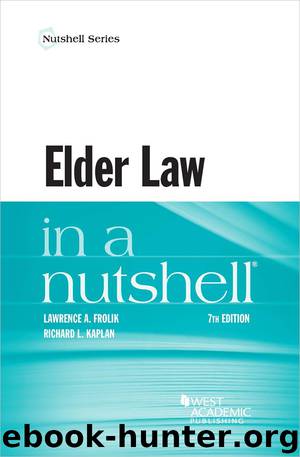Elder Law in a Nutshell by Lawrence A. Frolik & Lawrence A Frolik

Author:Lawrence A. Frolik & Lawrence A Frolik
Language: eng
Format: epub
ISBN: 9781640209060
Publisher: West Academic
Published: 2019-03-06T16:00:00+00:00
The desire of older persons to utilize the value of their home equity while continuing to live in their 219
home has spawned various mechanisms in addition to reverse mortgages. One of the most direct of these mechanisms is a home equity loan. Such loans are not uniquely developed for older homeowners, and in fact are usually not helpful. Most home equity loans provide either a line of credit to be drawn upon as the homeowner determines or a single lump sum—neither of which necessarily produces a dependable income stream. Worse, home equity loans typically require that the borrower demonstrate a dependable source of income that can support monthly repayment obligations. Most older homeowners do not want the obligation to make monthly repayments, and those homeowners most in need of additional income are not likely to have the income that is necessary to obtain a home equity loan. In some circumstances, however, a home equity loan might be suitable; e.g., to finance structural home improvements that will enable an older homeowner to remain in the home. But such circumstances are relatively limited.
A.Sale-Leasebacks
Another mechanism that taps an older person’s home equity is the sale-leaseback. In this transaction, the home is sold and then simultaneously leased back to the older person, generally for the rest of that person’s life. The sale side of this transaction provides the older homeowner with a downpayment that represents part of his or her equity in the residence, plus a stream of monthly payments that represent the balance of the purchase price. This series of monthly payments is sometimes 220
correlated to the older person’s remaining life expectancy. The leaseback side of the transaction assures the older person of continued occupancy of his or her residence, but at the cost of making monthly rental payments.
Ideally, the gain on the sale of the home will largely be shielded from income taxation by the $250,000/$500,000 residential gain exclusion explained in § 8.3. Furthermore, the monthly sale payments to the older person should exceed that person’s rent obligations, thereby providing the older person with an additional source of income while he or she lives in the home. Of course, rental payments tend to increase over time, thereby creating a source of financial uncertainty for the older person/tenant. But if the lease agreement limits these rental increases, the validity of the purported sale—or at least the purported sales price—may be questioned by the Internal Revenue Service (IRS). And if the sale is not valid, the older person will not be able to apply the residential gain exclusion. Moreover, even if the sale is valid, any gain in excess of $250,000 will be taxable to the older homeowner.
This question of rent increase limitations highlights one of the major hurdles of a sale-leaseback—namely, the conversion of the older homeowner into a tenant. In this new role, the older person necessarily gives up significant control of his or her property and may well resent the attending restrictions and resulting financial insecurity. Indeed, many older homeowners, having
Download
This site does not store any files on its server. We only index and link to content provided by other sites. Please contact the content providers to delete copyright contents if any and email us, we'll remove relevant links or contents immediately.
Machine Learning at Scale with H2O by Gregory Keys | David Whiting(4031)
Killers of the Flower Moon by David Grann(3921)
Oathbringer (The Stormlight Archive, Book 3) by Brandon Sanderson(2813)
Will by Will Smith(2754)
Once Upon a Broken Heart by Stephanie Garber(2636)
Guns, Germs and Steel by Diamond Jared(2256)
Borders by unknow(2174)
It Starts With Us (It Ends with Us #2) by Colleen Hoover(2164)
Friends, Lovers, and the Big Terrible Thing by Matthew Perry(2093)
The Room Where It Happened by John Bolton;(2083)
The Color of Law by Richard Rothstein(1857)
HBR's 10 Must Reads 2022 by Harvard Business Review(1750)
The Strength In Our Scars by Bianca Sparacino(1744)
A Short History of War by Jeremy Black(1739)
Water Rights and the Environment in the United States by John Burch(1633)
Examples & Explanations: Administrative Law by William F. Funk & Richard H. Seamon(1585)
515945210 by Unknown(1579)
A Game of Thrones (The Illustrated Edition) by George R. R. Martin(1541)
Pharmacy Practice and The Law by Richard Abood(1527)
